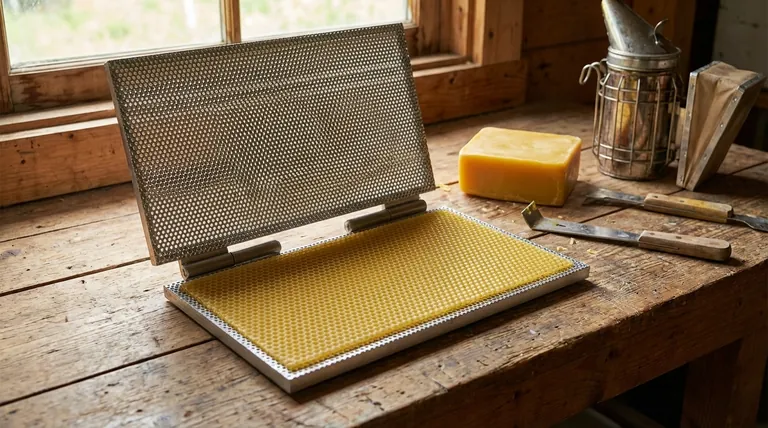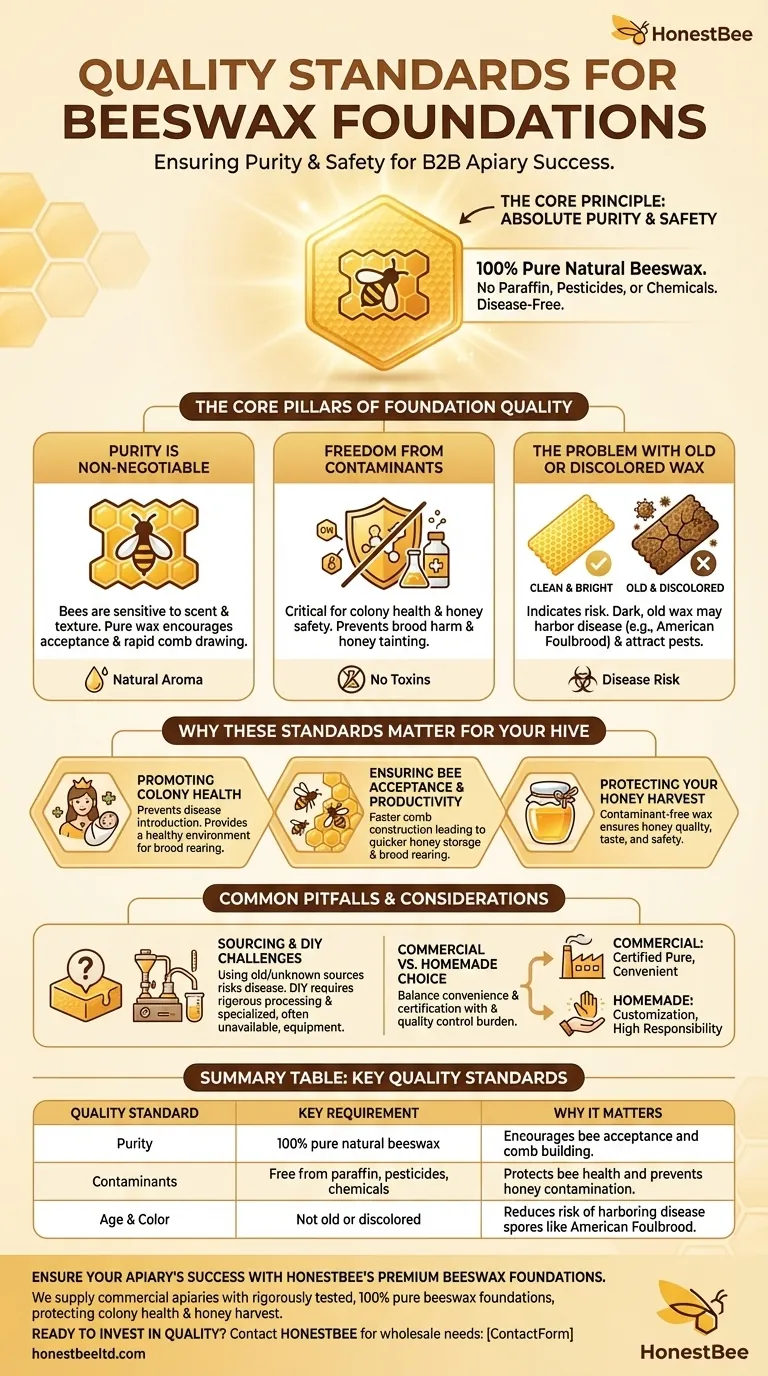The fundamental quality standard for beeswax foundation is absolute purity. To be suitable for use in a hive, the wax must be 100% pure, natural beeswax. It is rigorously tested and rejected if it contains any impurities such as paraffin, pesticides, or other chemicals. Furthermore, the wax cannot be old or discolored, as this indicates a potential risk of harboring infections or attracting pests.
The core principle of beeswax foundation quality is not just purity, but also safety. High-quality foundation uses wax that is confirmed to be free from chemical contaminants and disease, directly safeguarding the health of the colony and the integrity of the honey.

The Core Pillars of Foundation Quality
To understand what makes a foundation acceptable to a colony, we must look at the specific attributes of the wax itself. These standards are not arbitrary; they are based on the biological needs and health of the bees.
Purity is Non-Negotiable
A foundation must be made from 100% pure natural beeswax. Bees are highly sensitive to the scent and texture of their environment.
Pure wax has a familiar, attractive scent that encourages the bees to accept the foundation and begin "drawing it out" into comb quickly. Adulterated wax can slow or even halt this critical process.
Freedom From Contaminants
The wax must be completely free of foreign substances. This is a critical health and safety checkpoint.
Common contaminants like paraffin, pesticides, and other chemicals can be toxic to bees, harm brood development, and compromise the entire colony's health. These substances can also leach into the honey, rendering it unsafe for consumption.
The Problem with Old or Discolored Wax
The age and appearance of the wax are direct indicators of its safety. Clean, properly rendered beeswax has a pleasant aroma and a bright, uniform color.
Old or discolored wax is rejected because it may harbor disease spores, such as American Foulbrood, which can devastate a colony. Darker, older wax can also be more attractive to pests like wax moths.
Why These Standards Matter for Your Hive
Adhering to strict quality standards for foundation is a direct investment in the success and sustainability of your beekeeping operation. The quality of the foundation has immediate and long-term impacts.
Promoting Colony Health
Using clean, sterile wax is one of the most effective ways to prevent the introduction and spread of disease within a hive. It provides a healthy environment for the queen to lay eggs and for the colony to raise new generations of bees.
Ensuring Bee Acceptance and Productivity
Bees are far more likely to build upon a foundation that is made from pure, natural material they recognize. This rapid acceptance leads to faster comb construction, which in turn allows for quicker honey storage and brood rearing, boosting the colony's overall productivity.
Protecting Your Honey Harvest
The wax comb is the storage vessel for honey. If the wax itself is contaminated with pesticides or chemicals, those contaminants can migrate into the honey, affecting its quality, taste, and safety.
Common Pitfalls and Considerations
While the standards are clear, the practical application requires diligence. The primary challenge lies in verifying the source and history of the wax.
Sourcing Your Wax
If you make your own foundation, you are solely responsible for quality control. Using wax from old combs or unknown sources carries a significant risk of introducing diseases or contaminants into your equipment and hives. All wax must be thoroughly processed and filtered.
The DIY Equipment Challenge
The specialized equipment needed to make foundation, such as embossing rollers and dipping vats, is often not commercially available. Beekeepers who choose this path must typically build their own setup, adding a layer of complexity to ensuring a consistent, high-quality product.
Commercial vs. Homemade
Purchasing foundation from a reputable supplier offloads the burden of purity testing. However, making your own gives you complete control over customization, such as cell size, but places the entire responsibility for safety and quality on you.
Making the Right Choice for Your Goal
Your approach to sourcing foundation should align with your beekeeping philosophy and goals.
- If your primary focus is maximum hive safety and convenience: Purchase your foundation from a trusted commercial supplier who can certify their wax is 100% pure and has been tested for contaminants.
- If your primary focus is self-sufficiency and customization: Be prepared to invest in a rigorous system for cleaning, filtering, and processing your own beeswax to meet the highest purity standards before making foundation.
Ultimately, selecting high-quality foundation is a direct investment in the long-term health and productivity of your colony.
Summary Table:
| Quality Standard | Key Requirement | Why It Matters |
|---|---|---|
| Purity | 100% pure natural beeswax | Encourages bee acceptance and comb building. |
| Contaminants | Free from paraffin, pesticides, chemicals | Protects bee health and prevents honey contamination. |
| Age & Color | Not old or discolored | Reduces risk of harboring disease spores like American Foulbrood. |
Ensure your apiary's success with HONESTBEE's premium beeswax foundations.
We supply commercial apiaries and beekeeping equipment distributors with rigorously tested, 100% pure beeswax foundations. Our commitment to absolute purity and safety protects your colony's health, promotes rapid comb construction, and safeguards your honey harvest from contaminants.
Ready to invest in the highest quality for your hives? Contact HONESTBEE today to discuss your wholesale needs and learn how our products support your beekeeping operation's productivity and sustainability.
Visual Guide

Related Products
- Notebook Style Beeswax Foundation Mould Wax Foundation Mold
- Manual Beeswax Comb Foundation Machine Wax Foundation Mill Embossing Machine
- Electric Beeswax Foundation Machine With Operating Tray and Wax Foundation Roller
- Electric Beeswax Flat Sheet Machine with Operating Tray for Wax Processing
- Electric Flatting and Embossing Machine with Tray for Beekeeping
People Also Ask
- What is required when using wax foundation in beekeeping frames? Essential Support for Strong Combs
- What is the process for making beeswax sheets using a mold? A Step-by-Step Guide for Perfect Results
- How is beeswax foundation secured in wooden frames? Ensure Strong Comb for Healthy Hives
- How do bees build their honeycomb? A Marvel of Collective Engineering and Efficiency
- How do you use the Foundation Mold to create beeswax foundation? Master DIY Beekeeping with Precision



















